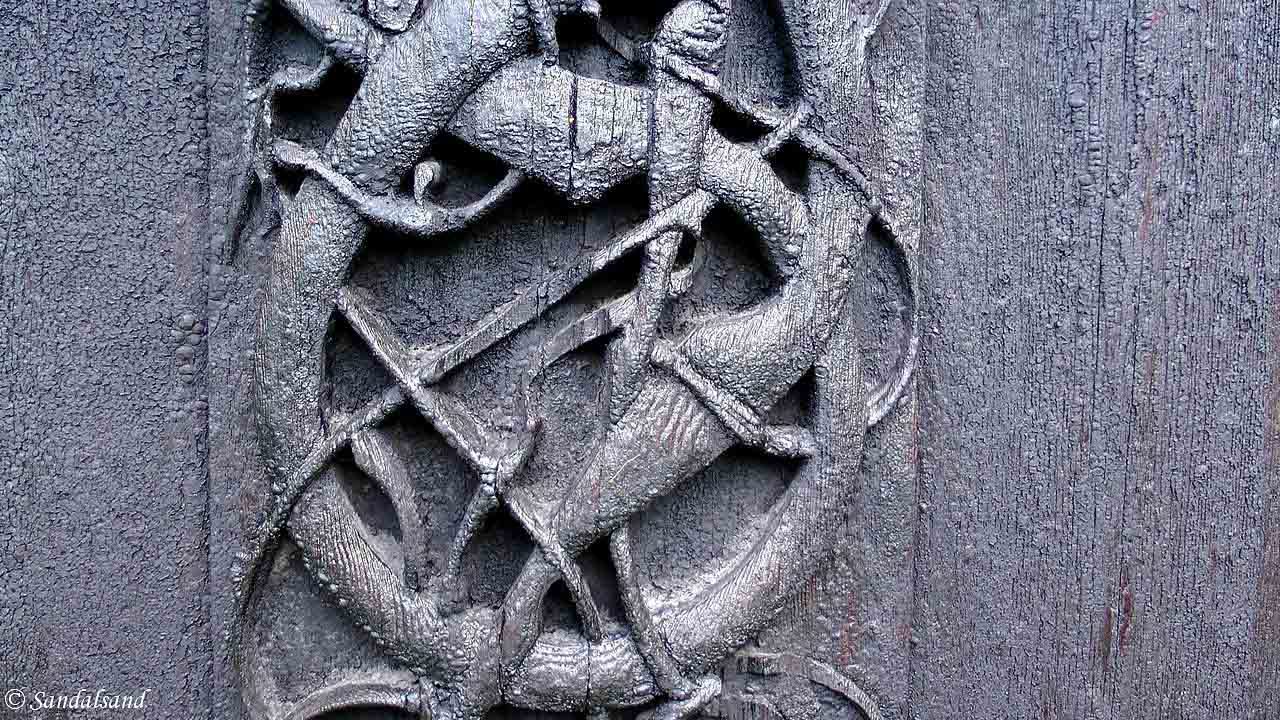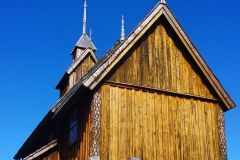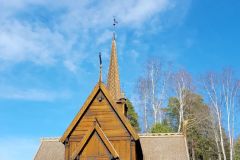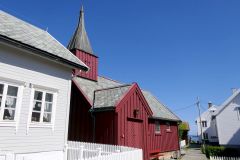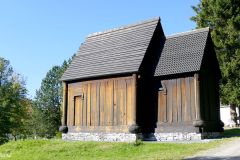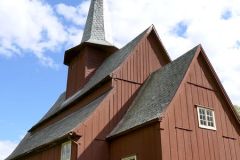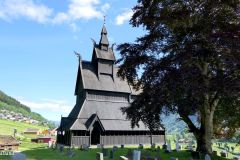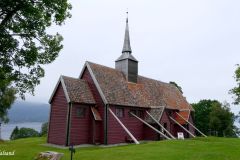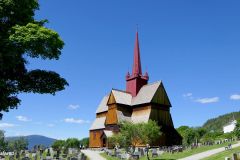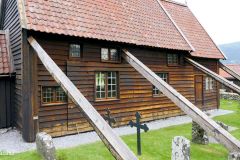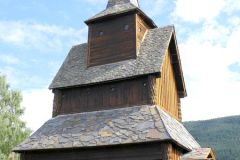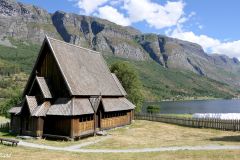The stave churches is the Norwegian contribution to the world heritage. They knew about the building technique elsewhere in Northern Europe as well. However, it became particularly popular in Norway. This is also were we find most of the remaining churches.
Introduction
Between 1130 and 1350 they built at least a thousand and perhaps twice as many stavkirker (stave churches) in Norway alone. Today only 29 churches remain, 28 of them in Norway. UNESCO inscribed the oldest, most decorated and most intact church, Urnes, on its World Heritage List.
This article provides a short introduction to the building technique, the history of the churches, and presents stave churches Sandalsand has visited.
Denne artikkelen er også tilgjengelig på norsk.
Map of stave churches in Norway
It is dynamic so move around in the map as you like or expand into a new window/tab. Green coloured markers indicate churches Sandalsand has visited and published an article about. Click a pin to reveal basic information (in Norwegian) like name, municipality, county, year of construction and GPS-location.
The construction of the stave churches
The basic building technique
“A stave church is a medieval wooden church with a post and beam construction related to timber framing. The wall frames have vertical planks. The load-bearing posts (stafr in Old Norse, stavin Norwegian) have lent their name to the building technique.” (Wikipedia)
The stave churches draws on two earlier construction techniques. Bits and pieces of these have been discovered underneath the present stave churches.
The “palisade” construction was familiar in the Viking era. They divided the logs into two, drove them into the ground and put up a roof on top.
The next technique was to place a horizontal sill under the vertical logs forming the wall. Only the corner posts would be in the ground, hence the term “post” construction technique.
The next step gradually moved into the defining characteristic of the “stave” churches. This means that the horizontal sill on the bottom of the wall and the corner posts rest on stones. Removing the wood from direct contact with the ground clearly increased its lifespan.
Types of churches
One usually divides the stave churches into two types.
The “single nave church” has no free standing internal posts raising the central roof higher than its walls. Some of them are square, some rectangular and some in this group does have a singular post in the middle inside supporting the roof. 14 of the 28 remaining churches are of this type.
The other type is a more complicated construction. It is a “church with a raised roof”. 11 of the 28 churches have this characteristic construction. (These figures do not add up to 28 and I can’t explain the difference.)
Use of timber
The old Vikings certainly knew how to pick their timber. For the stave churches they logged (Scots) pine trees in mountainous areas. These would have been growing very slowly and were rich in heartwood, making them very hard and durable. They used this timber for the parts of the church that were particularly vulnerable to weather.
Decorations inside and outside
The stave churches are not lavishly or colourfully decorated. The most admired elements are probably the carved portals, of which the one at Urnes is the most notable.
History of the stave churches
The historical period they appeared in
Norway was largely converted to Christianity through influence from Great Britain. The last battle against the pagans was at Stiklestad in the year 1030. Here King Olav died. He was later sanctified. In the following years they built a number of churches. The stave churches as we know them today date from about a hundred years after this battle. These medieval churches were of course heavily influenced by Christianity. But also Celtic ornamentation and Norse traditions and mythology found their place in the decoration.
Why they stopped building them and demolished so many
From the beginning of the 12th century until around 1350 they built more than a thousand stave churches in Norway, perhaps as many as 2000. Then the Black Death hit the country and decimated the population. From 1348 to 1350 we believe that 60 % of Norwegians died from this plague. A series of other plagues hit the country (and Europe) over the next 300 years as well.
This contributed to a large degree to the weakening of Norway as an autonomous country and it fell under Danish and later Swedish rule. In this situation there would be no need for more churches and they had to neglect maintenance of existing churches. They also merged a number of parishes as a result of the declining population.
In addition the Reformation from the middle of the 16th century put up other demands for churches. The final blow came in the middle of the 19th century when new regulations stated that larger congregations needed larger churches. The remaining 28 churches are all located (apart from the ones in central museums) in remote and poor areas of the country. This distribution has probably contributed to their preservation of sorts throughout the centuries.
It was not until late in the 19th century that the idea of preserving the stave churches as a national heritage became viable.

Changes in appearance over the years, reconstruction and deconstruction
The stave church construction is simple and recognisable. Viewing the churches from the outside and inside the dominant perspective is however a different one; that of variation. Not two of them look alike, and some do not look like a stave church at all. The only common denominator is the basic stave construction.
Some churches have been removed from their original location and set up elsewhere. All 28 have been reconstructed, restored and changed multiple times over the centuries.
Preservation of stave churches today
All remaining stave churches are today prime national heritage objects. The Urnes stave church is also on UNESCO’s World Heritage List as a representative of the rest.
Quite a lot of voluntary and public efforts (and money) goes into preservation of the churches. The main idea is not to restore to a previous (original) state, but to preserve the churches as they are now, by using the same old techniques, tools and wood as they did 900 years ago.
Introduction to each of the stave churches
Here you get an introduction with links to in-depth articles from 21 visited stave churches. This means, firstly, that this article, first published in 2012, is a living document. Secondly, the author has a desire to visit the remaining seven stave churches: Flesberg, Hedalen, Høyjord, Nore, Reinli, Undredal, and Uvdal.
Here are short reviews and links to Sandalsand’s visited stave churches, in alphabetical order. The introductions are basically Google translates from the original Norwegian source and links lead to the individual articles on Sandalsand Norge using Google Translate.
Borgund
Borgund Stave Church is located in Lærdal municipality in Vestland county. It dates back to the end of the 12th century. The church was strategically located on the old traffic road over Filefjell, between east and west in Norway. This is an absolutely stunning beauty. It is the best preserved of all stave churches. In addition it looks like a stave church should look like. Read more .
Eidsborg
Eidsborg Stave Church is located in Tokke municipality in Vestfold and Telemark. It is one of the country’s smallest stave churches, but the height of the spire, the aisle and the location at the top of the hill make Eidsborg stave church appear larger. Read more .
Garmo
Garmo Stave Church from Lom in Innlandet county was built in the 13th century. This amazing old stave church has been taken care of for posterity. The church from Garmo is found at the Maihaugen open-air museum in Lillehammer. However, there are some “buts” associated with the stave church. Read more .
Gol
Gol Stave Church stands at the Norsk folkemuseum in Oslo. It has not only been moved, but also copied up to several times. Get to know the original. It is one of the most beautiful stave churches we have. Read more .
Grip
Grip Stave Church is one of our smallest and least accessible stave churches. It is located on the island of Grip, an hour’s boat ride west of Kristiansund. It is common to date the church to the latter half of the 15th century, which means that it is fairly new in the stave church context. Read more .
Haltdalen
This is a small church inside the open-air museum at Sverresborg in Trondheim. Haltdalen stave church has the status of one of the country’s remaining 28 stave churches. In reality, it is the composition of two churches. There is nothing left of the interior. The rest was largely reconstructed. Still: The church is an important cultural monument, and of course protected. Read more .
Heddal
There is a very stately stave church in Heddal just west of Notodden in Vestfold and Telemark. It dates back to the beginning of the 13th century. Heddal is the country’s largest, and it also has very beautiful decorations both inside and out. Read more .
Hegge
Hegge Stave Church in Øystre Slidre (Valdres) was built a little after 1216, but was actually moved to this place much later and composed of two churches. The stave church excels in three ways. Here you can get up to the attic and study the building technique, it is the one of the stave churches that is highest above the sea (659 m), and it is still in use as a parish church. This bodes well in principle, but stave church fans will probably still be disappointed when they come here. Read more .
Hopperstad
Hopperstad stave church is located at the foot of new and old roads over Vikafjellet, just south of the Sognefjord. The church is one of the oldest stave churches, but at the end of the 19th century it was given a different expression than it originally had. Borgund stave church served as inspiration for the restoration made by the Bergen architect Blix in the 1880’s. Read more .
Høre
This stave church is located in Vang municipality in Innlandet county. In the summer of 1179, the brothers Elling and Audun went out into the woods to cut down trees. They were to become the new church at Høre. We can read this on a runic inscription in the church. A modern dating of the wood confirms the timing. We do not know whether they began construction the same year, or the year after. However, it is clear that it was not the first church on the site. Traces of an older pillar church have been found in the ground. Read more .
Kaupanger
Kaupanger Stave Church is located in Sogndal municipality in Western Norway. It was built around 1140 and is one of our oldest. The church has been rebuilt and expanded, and was also painted white like other churches in Norway in the 19th century. But the medieval construction is intact, and it is considered a well-preserved church. Read more .
Kvernes
Kvernes Stave Church is the only one of our stave churches that dates from after the Middle Ages. The church has a brilliant location on Averøy in Møre og Romsdal. It was long common to date it to the beginning of the period 1300-1500. Brand new studies of the wood in the church, however, showed that it is from 1631-33. Read more .
Lom
Lom Stave Church is one of our oldest, largest and most beautiful stave churches. The timber for the oldest part was cut in the winter of 1157/58. The dragon heads on the roof are also from the Middle Ages. Read more .
Lomen
At the end of the 12th century, stave churches were built in large numbers in Valdres. This church in Vestre Slidre (Innlandet county) was built at about the same time as Høre only a few kilometres away. It is a beautiful old church in a beautiful cultural landscape that welcomes us. Although Lomen Stave Church has not been significant in church use for the past hundred years, it has a history like few others. 800 years is a serious age for a wooden building. Read more .
Ringebu
Ringebu Stave Church is one of our largest and most powerful stave churches. With its red spire, it is markedly located on the slope above Gudbrandsdalslågen. It is most often dated to 1220, but the shape we can experience today is from the 17th century. The church has been restored several times since then. Read more .
Rollag
Rollag Stave Church is located in the municipality of the same name, in Viken county. It is a small single-aisled church built in the second half of the 12th century. Not much is left from that time. ( Sandalsand has no own photos of this church, just a very old and short video clip of no public interest.)
Rødven
Rødven Stave Church is not like other stave churches. On the outside, there is little reminiscent of the relationship, but the charming church by the fjord has an alluring 700-year history. While many other Norwegian stave churches were “modernised” in the 19th century, Rødven has kept its interior relatively unchanged. It is very authentic. Read more .
Røldal
Røldal Stave Church is located in Ullensvang municipality in Western Norway. Norway’s third most important pilgrimage destination through the Middle Ages could not be stopped by repeated bans on such activities. In our day, even the national Lutheran church authority has blessed pilgrimages to this modest 13th-century church building. Read more .
Torpo and Hallingdal
This stave church in Ål municipality in Viken county, is from the very end of the 12th century. Torpo Stave Church between Gol and Geilo is Hallingdal’s oldest building and only stave church. There is a lot of medieval above it, on the outside as well as inside. Nevertheless, the stave church appears as a slightly strange and not least ribbed construction. Read more .
Urnes
Urnes Stave Church is located in Luster municipality in Western Norway, and dates back to the first half of the 12th century. The church is generally regarded as the oldest of the 28 stave churches and is recognised for its very fine woodwork. The carvings are fantastic. Urnes Stave Church is a World Heritage Site, selected by UNESCO as a place of unique universal value and thus a central part of the world’s cultural heritage. Read more. Also read Sandalsand ‘s English language introduction to the UNESCO listing of Urnes.
Øye
Øye Stave Church is located in Vang municipality in the county of Innlandet, and was built around the year 1200. There is something doubly religious about Øye stave church in Valdres. It died at the time of the demolition in 1747, was buried under a new church for almost 200 years, and then resurrected in a slightly different place. No one should believe it when we visit it today, because it appears as having always been here. Read more .
Read more
If you have an interest in stave churches, check out Sandalsand’s sources.
- Wikipedia’s articles about stave churches in English, Norwegian and Swedish.
- The Society for the Preservation of Norwegian Ancient Monuments (Fortidsminneforeningen) owns and runs nine stave churches.
- Stavkirke.info is a website in Norwegian by a Jørgen H Jensenius. The site has information in English and Norwegian.
- The term “Stavkirke” in Store Norske Leksikon (Encyclopedia in Norwegian)
- English language page on the website belonging to Norwegian tourism authorities.
- The Directorate for Cultural Heritage has information in Norwegian about their restoration programme.
- “De norske stavkirkene” by Leif Anker (ARFO, 2005) is the most comprehensive book yet about the Norwegian stave churches. It presents updated information from research, stave churches in general and gives thorough presentations of all churches – in Norwegian.
Many stave churches are located in the beautiful fjords of Western Norway. There are many more relevant articles on this blog. Read my introduction to Norway, the fjord country. These posts all have videos describing them in more detail. Find the videos in a Norway playlist on my YouTube channel.

